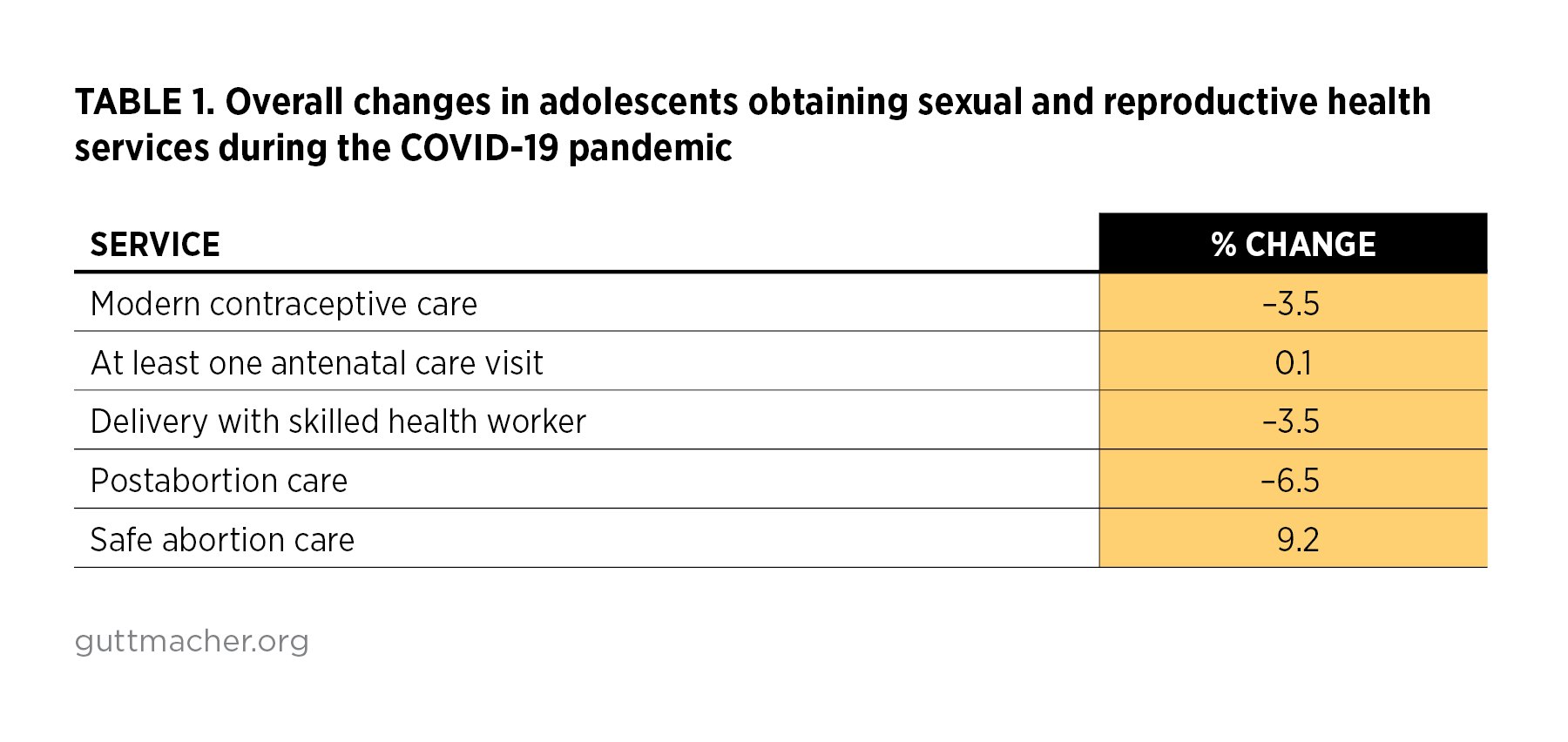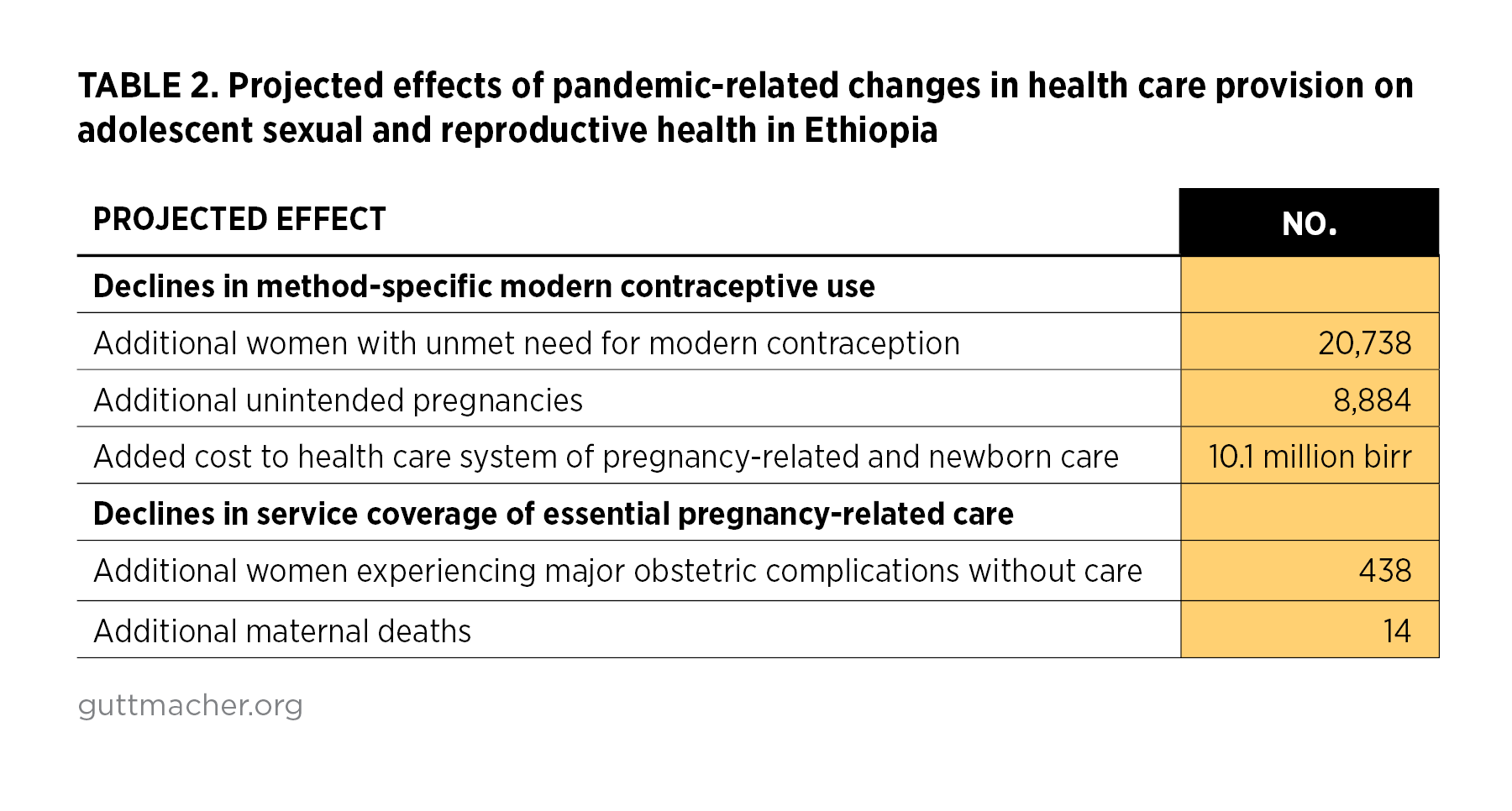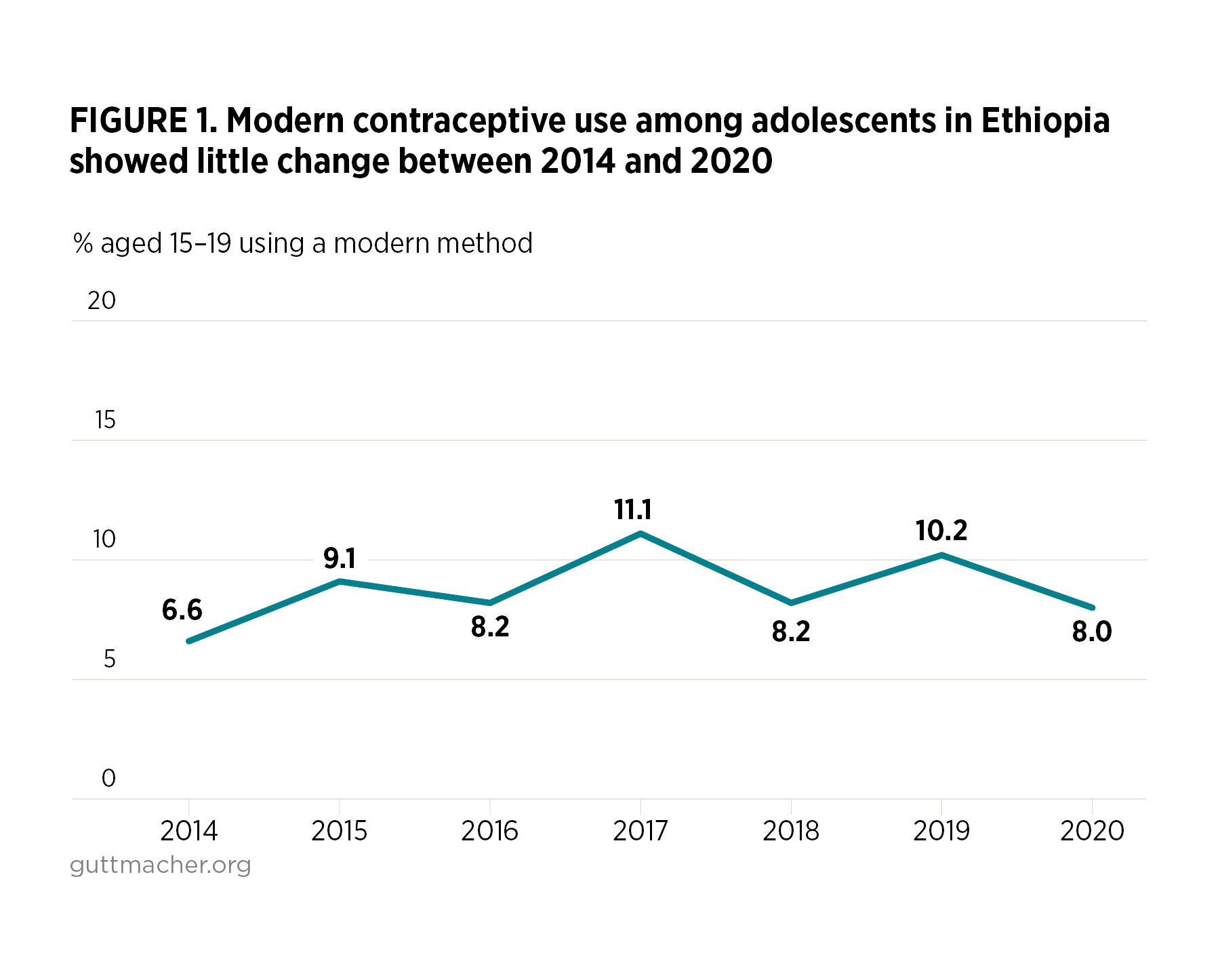- The COVID-19 pandemic and its associated restrictions raised concerns that adolescents in Ethiopia may face reduced access to youth-friendly sexual and reproductive health services.
- Public and private service statistics data reveal that from March through the end of 2020, the COVID-19 pandemic had at least a short-term impact on adolescent sexual and reproductive health outcomes.
- The COVID-19 pandemic is estimated to have resulted in an annualized increase of:
- 20,738 adolescents with an unmet need for contraception
- 8,884 unintended pregnancies among adolescents
- Approximately 10.1 million Ethiopian birr (more than US$250,000) in costs for the Ethiopian health system for pregnancy-related and newborn care
- 438 adolescent women with major obstetric complications
- 14 adolescent maternal deaths
- Ethiopia’s Ministry of Health and private health providers could take several steps to ensure that access to sexual and reproductive health services for adolescents continues throughout the remainder of the COVID-19 pandemic:
- Adopt an emergency response plan that addresses adolescents’ sexual and reproductive health needs
- Support health care workers, particularly health extension workers, to increase access to contraceptives for adolescents
- Engage adolescents at all levels of the Ministry of Health decision-making process
- Support the expansion of youth-friendly services across regions with additional staff and resources
Impact of the COVID-19 Pandemic on Adolescent Sexual and Reproductive Health in Ethiopia

Author(s)
Assefa Seme, Solomon Shiferaw, Ayanaw Amogne, Anna Popinchalk, Leilena Shimeles, Ephrem Berhanu, Ricardo Mimbela and Margaret GiorgioReproductive rights are under attack. Will you help us fight back with facts?
Key Points
Introduction
Twenty-three percent of Ethiopia’s estimated 117.9 million people are aged 10–19.1 Young people often face major sexual and reproductive health challenges, including a lack of access to services and high levels of child marriage, early childbearing, unintended pregnancy, unsafe abortion and exposure to STIs, including HIV.
Ethiopia’s Ministry of Health has made adolescent sexual and reproductive health a major priority in recent years and is currently updating its National Adolescent and Youth Health Strategy to respond to the needs of adolescents and youth. The strategy aims to improve the overall health status of adolescents and youth, with the ultimate goal of realizing young people’s full potential in national development. In service to this goal, the Ministry of Health has instituted the provision of youth-friendly services in hospitals, health centers and partner clinics. In addition to the services offered under the strategy, One Stop Centers were established to provide holistic medical and psychological care for adolescents, as well as legal support services to survivors of gender-based violence.
The COVID-19 pandemic has presented a major threat to this progress. In April 2020, the government of Ethiopia declared a state of emergency, followed by restrictions on or prohibitions of public gatherings, border crossings and the availability and capacity of transportation services. Health facilities had to shift capacity and services to aid in the COVID-19 response, which compromised the availability of youth-friendly services, as space and staff were repurposed to COVID-19 services. School closings to mitigate the spread of the virus had additional implications for adolescents’ receipt of sexual and reproductive health care, as youth often accessed such services either during school time or on their way to or from school. Finally, there also were anecdotal reports of sexual and gender-based violence following the closure of schools.
To understand how adolescent sexual and reproductive health was affected during the months following the start of the COVID-19 pandemic, this report uses service statistics data from 2019 and 2020 to analyze changes in service coverage across three main areas of adolescent sexual and reproductive health care: modern contraceptive care, pregnancy-related and childbirth care, and safe abortion care. It estimates the impact of observed service changes on the number of adolescents aged 15–19 in need of these services and the resulting impact on unintended pregnancies, unplanned births, abortions and maternal deaths, as well as the added cost to the health system from these disruptions. This report also makes the case to national stakeholders for increased resources to improve adolescent health care coverage and sexual and reproductive health outcomes.
Methods
A detailed description of the data sources and analytic techniques used in this report is provided in the Data and Methods Appendix (download above). In brief, data come from the following sources:
- Ethiopia’s two largest private providers of sexual and reproductive health services, referred to here as Private Provider #1 and Private Provider #2, supplied service delivery data for 2019 and 2020. For Private Provider #1, we compared levels of service provision from March to December 2019 with those of March to December 2020. For Private Provider #2, we compared their internal projections for caseloads from March to November 2020 with the number of actual client visits during that time frame.
- Service delivery data for 2019 and 2020 from Ethiopia’s District Health Information System 2 were used to examine changes in adolescents’ use of public sexual and reproductive health services before and during the pandemic.
- To understand overall trends in modern contraceptive use among adolescent women, as well as to provide insight into what proportions of adolescents accessed services in public vs. private facilities, we abstracted additional national-level data from population-based surveys conducted by the Performance Monitoring for Action Ethiopia project.2
We first calculated changes in service visits between 2019 and 2020 using data from Private Provider #1, Private Provider #2 and the District Health Information System 2 for each of the key study measures: visits for modern contraceptive care, receipt of at least one antenatal visit during pregnancy, deliveries with skilled health personnel, and the number of postabortion care and safe abortion care clients. (Most of this information is for female adolescents, although men’s visits for external condoms are included as well.) Next, we combined this information to estimate nationwide changes in service visits for these measures. Finally, we used methodology from the Guttmacher Institute’s 2019 Adding It Up study to estimate the impact that these changes had on key sexual and reproductive health outcomes among adolescents in Ethiopia, including unmet need for contraception, unintended pregnancy and any costs to the health care system associated with increased unintended pregnancy, maternal morbidity and mortality, and unsafe abortion.3,4
How the COVID-19 Pandemic Affected Adolescents’ Health
Declines in service delivery were observed in the District Health Information System 2 data, as well as in those for Private Provider #1 (though not in every service category). Private Provider #2 received a large new grant early in 2020, which resulted in the addition of new service sites and the expansion of services. As a result, we were unable to compare data for 2019 with those for 2020 for this provider. Instead, we conferred with program staff, who believed that other than causing some short-term dips in service delivery in March and April 2020, the COVID-19 pandemic did not ultimately produce any major or lasting declines in service delivery between 2019 and 2020. Therefore, for this analysis, we assumed no declines in service delivery for Private Provider #2.
After combining all available data, we estimate that the pandemic resulted in declines of roughly 3.5% in the numbers of adolescents receiving modern contraceptive care and those giving birth with a skilled health worker (Table 1). We also estimate a 6.5% drop in the number of 15–19-year-olds receiving postabortion care. We found little change in the number of adolescent clients who received at least one antenatal care visit, and we estimated that the use of safe abortion care increased by approximately 9%.
After including the observed decline in contraceptive care in the Adding It Up model, we estimate that there were an additional 20,738 adolescents with an unmet need for contraception in Ethiopia, resulting in an additional 8,884 unintended pregnancies over the course of a year (Table 2). This increase in unintended pregnancies cost the Ethiopian health system an additional 10.1 million Ethiopian birr for pregnancy-related and newborn care in 2020 (the equivalent of approximately US$255,920).
The declines in maternal and child health care would ultimately result in an estimated additional 438 cases of major obstetric complications and 14 maternal deaths among adolescents in Ethiopia over the course of a year.
Use of safe abortion care appears to have increased in Ethiopia between the onset of the COVID-19 pandemic and the end of 2020 (Table 1). This may reflect the estimated uptick in unintended pregnancies; however, it may also be the result of concentrated efforts by the Ministry of Health to increase access to safe abortion care in Ethiopia, or some combination of these two factors. In either case, we do not believe that unsafe abortions increased in Ethiopia as a result of the COVID-19 pandemic.
Using the Performance Monitoring for Action data, we observed a decrease between 2019 and 2020 in the proportion of adolescents who used modern contraceptives, from 10% to 8% (Figure 1). However, this decrease was no larger than other fluctuations in contraceptive use seen in recent years. More data are needed to understand whether the COVID-19 pandemic resulted in a sustained decrease in modern contraceptive use among Ethiopian adolescents.
Discussion and Recommendations
Overall, our analyses indicate that the COVID-19 pandemic likely had a negative impact on adolescent sexual and reproductive health, specifically regarding unmet need for modern contraception and unintended pregnancies. While declines in care and increases in these outcomes were smaller than what some policymakers and service providers had initially feared, they still represented a significant burden on the Ethiopian health care system.
Based on these findings, Ethiopia’s Ministry of Health and private health care providers could take several steps to ensure that adolescents have continued access to sexual and reproductive health services throughout the remainder of the COVID-19 pandemic:
- An emergency response plan should be put in place by the Ministry of Health to address sexual and reproductive health needs, including those of adolescents and youth, during emergency situations such as the pandemic.
- Public and private health care systems should provide support to all health care workers, ranging from technical support and capacity strengthening to financial support (such as allowances). This would be particularly important for health extension workers, who go door-to-door to educate community members and deliver some services and can help reach adolescents with information and care.
- The Ministry of Health should engage adolescents and youth at all levels of their decision-making processes, especially in matters that affect young people’s lives.
- Stand-alone and integrated youth-friendly services should be expanded across regions, and the Ministry of Health should work with schools to communicate clear information about these services.
REFERENCES
1. United Nations Population Fund, World population dashboard: Ethiopia, 2021, https://www.unfpa.org/data/world-population/ET.
2. Performance Monitoring for Action (PMA), PMA2020/Ethiopia June-July 2018 (Round 6), Family Planning Brief, Baltimore, MD, USA: Bill & Melinda Gates Institute for Population and Reproductive Health, 2018, https://www.pmadata.org/sites/default/files/data_product_results/PMA202….
3. Sully EA et al., Adding It Up: Investing in Sexual and Reproductive Health 2019, New York: Guttmacher Institute, 2020, https://www.guttmacher.org/report/adding-it-up-investing-in-sexual-repr….
4. Darroch JE, Adding It Up: Investing in Contraception and Maternal and Newborn Health, 2017—Estimation Methodology, New York: Guttmacher Institute, 2018, https://www.guttmacher.org/report/adding-it-up-investing-in-contracepti….
Suggested Citation
Seme A et al., Impact of the COVID-19 Pandemic on Adolescent Sexual and Reproductive Health in Ethiopia, New York: Guttmacher Institute, 2021, https://www.guttmacher.org/report/impact-covid-19-on-adolescent-srh-eth….
Acknowledgments
This report was written by Assefa Seme, Solomon Shiferaw and Ayanaw Amogne, all of Addis Ababa University, Addis Ababa, Ethiopia; Leilena Shimeles and Ephrem Berhanu, of Talent Youth Association, Addis Ababa; and Anna Popinchalk, Ricardo Mimbela and Margaret Giorgio, of the Guttmacher Institute, New York. It was edited by Michael Klitsch, and the figure was designed by Michael Moran, both of the Guttmacher Institute. The authors thank the Ethiopian Ministry of Health, the Performance Monitoring for Action project and the two private health services providers for providing access to the data used in these analyses.
Additional Downloads
- Data and Methods Appendix adolescent-srh-ethiopia-data-methods-appendix.pdf
Topic
Global
Tags



